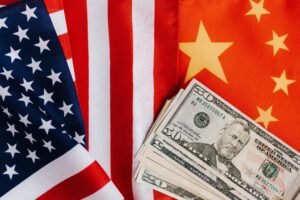Role of the U.S. president in the state

ABSTRACT :
The role of the U.S. president is complex and dynamic, intricately woven into the fabric of American governance. As director-in-chief, commander-in-chief, and chief diplomat, among other roles, the President is at the helm of national leadership.
This abstract explores the multifaceted responsibilities that define the presidency, from shaping domestic and foreign policy to leading the nation through crises. As an evolving institution, the presidency reflects constitutional principles and the distinctive characteristics of each individual who assumes the office.
By examining historical precedents and contemporary challenges, this abstract sheds light on the enduring importance of the U.S. presidency in steering the course of the United States and influencing the global landscape.
KEYWORDS :
In the complex tapestry of American governance, the role of the President of the United States emerges as a fundamental pillar embodying the highest level of executive authority. As defined by the United States Constitution, this pivotal position confers upon its occupants several responsibilities that go far beyond policymaking.
The president is not merely a political puppet; instead, they are the chief architect of the nation’s direction, tasked with protecting its interests, promoting the general welfare, and promoting the principles upon which the republic was founded. The road to the presidency is marked by an arduous democratic process, where candidates navigate the convoluted landscape of campaigns, debates, and elections to earn the American people’s trust.
After the inauguration, the President enters the role with the weight of history and the expectations of a diverse population. This introduction delves into the multifaceted responsibilities of the presidency, exploring the President’s role as commander-in-chief, director-general, chief diplomat, and more. It will also explore the nuances of leadership in times of crisis, the intricate dance with the legislative and judicial branches, and the President’s unique platform to shape the national narrative on the domestic and global stage.
As we explore the American President’s role, we uncover the layers of influence, decision-making, and legacy that define one of the most powerful offices in the world.
HISTORICALLY BACKGROUND
1789–1797: George Washington
Washington served as the United States’ first president after leading the Continental Army to victory in the American Revolutionary War.
1797–1801: John Adams
Adams became the second president to face challenges such as the XYZ Affair and pass the Alien and Sedition Acts during his term.
1801–1809: Thomas Jefferson
The third president, Jefferson, is known for the Louisiana Purchase and the Lewis and Clark expeditions that expanded the country’s territory.
1809 – 1817: James Madison
The fourth president, Madison, led the nation through the War of 1812 against Britain.
1817 – 1825: James Monroe
Known as the “Era of Good Feelings,” Monroe’s presidency included the Monroe Doctrine, asserting U.S. influence in the Western Hemisphere.
1825 – 1829: John Quincy Adams
Adams, the son of John Adams, served a single term and struggled with economic problems and internal improvements.
1829 – 1837: Andrew Jackson
Jackson, the seventh president, was a populist figure known for policies such as Indian removal and his role in expanding suffrage.
1837 – 1841: Martin Van Buren
The eighth president, Van Buren, faced economic problems during the Panic of 1837.
1841: William Henry Harrison
Harrison, the ninth president, had the shortest presidency, dying after only 31 days in office.
1841 – 1845: John Tyler
Tyler, the first vice president to assume the presidency due to the death of a sitting president, dealt with issues related to the annexation of Texas And so on until now. Each presidency brings challenges, achievements, and historical significance, contributing to the evolving story of the United States.
LITERATURE REVIEW:
Here, of course, is a selection of literature about U.S. presidents written by various authors, each offering unique perspectives and insights into the lives and presidencies of multiple leaders:
“A Team of Rivals: The Political Genius of Abraham Lincoln” by Doris Kearns Goodwin examines Lincoln’s leadership during the Civil War, highlighting his ability to unite conflicting personalities in his Cabinet.
“John Adams” by David McCullough: Delving into the life of the second president, John Adams, McCullough offers a comprehensive biography that explores his role in the nation’s founding.
“The Rise of Theodore Roosevelt” by Edmund Morris: Morris provides a detailed account of Theodore Roosevelt’s early life and political career, capturing his dynamic personality and contributions to American history.
“Lyndon B. Johnson: The Transition of Power” by Robert A. Caro: Caro’s multi-volume biography of Lyndon B. Johnson, including this sequel, examines Johnson’s presidency and the challenges he faced during a tumultuous period.
“Thomas Jefferson: The Art of Power” by Jon Meacham: Meacham explores the life and political understanding of Thomas Jefferson and illuminates his complex role in shaping the United States.
“The Fate of the Republic: A Story of Madness, Medicine, and the Assassination of a President” by Candice Millard tells the story of James A. Garfield, focusing on his presidency and the tragic events surrounding his assassination.
“Eisenhower in War and Peace” by Jean Edward Smith: Smith’s biography provides a comprehensive look at Dwight D. Eisenhower, examining his military and political career, including his time as President.
“Theodore Rex” by Edmund Morris: Another work by Morris, this book continues to explore Theodore Roosevelt’s presidency, covering his dynamic leadership and impact on the nation.
“Ronald Reagan” The Power of Conviction and the Success of His Presidency” by Peter J. Wallison analyzes Ronald Reagan’s presidency, focusing on his beliefs and the transformative policies that defined his time in office.
“The Wright Brothers” by David McCullough: While McCullough’s book on the Wright brothers does not focus solely on the presidency, it provides insight into the era of William Howard Taft and the early history of aviation.
FRAMEWORK:
These books offer different perspectives on U.S. presidents and provide readers with a rich understanding of the individuals who shaped the nation’s Role of the U.S. President based on historical and general information up to my last knowledge update in January 2022. See Current Resources for the latest and most specific data.
Executive Director:
The President serves as chief executive, responsible for implementing and enforcing laws, overseeing executive agencies, and making significant domestic and foreign policy decisions.
Commander-in-Chief:
The President is the commander-in-chief of the U.S. military, with the authority to make military decisions, deploy forces, and respond to national security threats.
Chief Diplomat:
The President plays a crucial role in shaping U.S. foreign policy, conducting diplomacy, negotiating treaties (subject to Senate approval), and representing the country globally.
Legislative Leader:
While the President cannot make laws directly, he can influence the legislative process by proposing legislation, vetoing it, and working with Congress to shape the legislative agenda.
Economic leader:
The President has a role in economic affairs, influencing taxes, spending, and trade policies. They work with financial advisors to solve problems such as unemployment and inflation.
Crisis manager:
In times of crisis, whether natural disasters or emergencies, the President takes on a leadership role, coordinating federal agencies and providing leadership to the nation.
Leading Party:
The President is often seen as the leader of their political party, playing a role in shaping party platforms, endorsing candidates, and supporting party initiatives.
Head of State:
As the ceremonial head of state, the President performs symbolic duties such as bestowing honors, hosting state dinners, and representing the nation at public events.
Policy Initiator:
The President can propose policy initiatives and advocate for specific legislative programs, setting the tone for national debates on various issues.
Public communicator:
Effective communication is a crucial aspect of the role of the president. They address the nation, communicate policy decisions, and use the “bully pulpit” to sway public opinion.
These qualitative aspects provide a broad understanding of the multifaceted role of the U.S. president. Consider linking to scholarly articles, government reports, and reputable news sources for more detailed and up-to-date information.
FAQS of U.S. president:
Who was the first president of the United States?
George Washington.
Who is the United States president at the moment?
Joe Biden
What is the length of the term of office of the President of the United States?
Four years, maximum two terms.
Who is the United States’ vice president at the moment?
To my last knowledge update in January 2022, Kamala Harris.
How many presidents have been impeached in U.S. history?
Three: Donald Trump, Bill Clinton, and Andrew Johnson.
What is the presidential line of succession?
The Vice President, the Speaker of the House, the President pro tempore of the Senate, followed by the members of the Cabinet in the order in which their department is established.
Who was the only U.S. president to resign?
Richard Nixon.
Three: Donald Trump, Bill Clinton, and Andrew Johnson
Advise the President on their respective departments and help shape national policy.
What is the minimum age requirement to run for President?
At least 35 years.
What is the State of the Union address?
The President’s annual address to Congress that outlines the administration’s legislative agenda.
How many presidents have been assassinated while in office?
Four: Abraham Lincoln, James A. Kennedy, William McKinley, and Garfield.
CONCLUSIONS:
In conclusion, the role of the U.S. President is multifaceted and dynamic and includes, among others, the duties of CEO, Commander-in-Chief, and Diplomat-in-Chief. Throughout American history, presidents have shaped the nation’s destiny, navigated complex challenges, and impacted domestic and global affairs. As the leader of the free world, the American President occupies a unique position, not just as a political puppet but as a symbol of the nation’s ideals and aspirations. Marked by its constitutional framework and historical development, the presidency remains a central force in the ongoing narrative of the United States, reflecting the ever-changing demands and aspirations of the American people.
Visit: Timebuissnesnews.com








